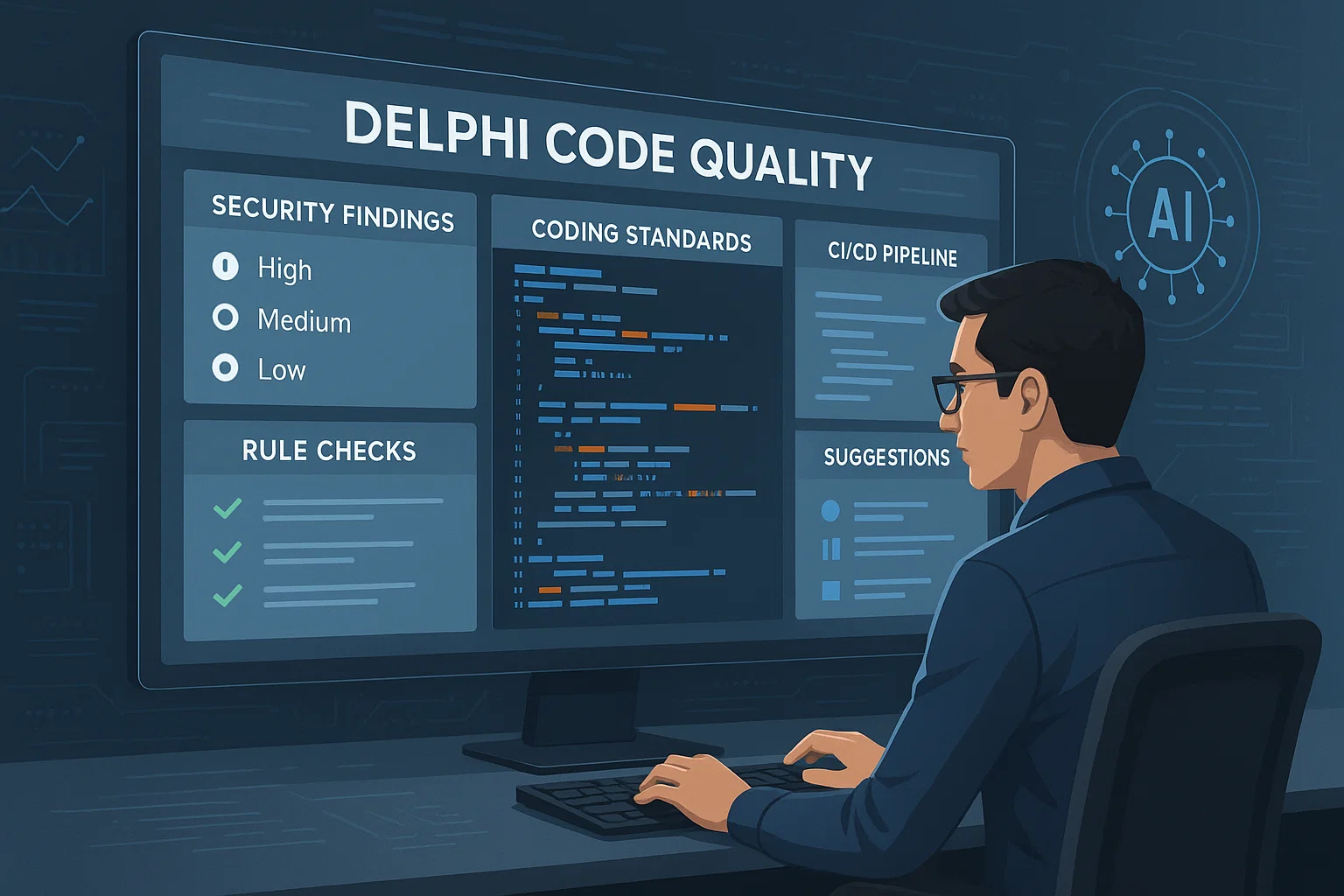DerScanner > Blog > Healthcare Delphi Applications: HIPAA Security Requirements

Healthcare Delphi Applications: HIPAA Security Requirements
Since the compliance date of the Privacy law, the HHS Office for Civil Rights (OCR) has imposed over $144 million in HIPAA violation penalties, with unique settlements ranging from a few thousand to $16 million. Technical vulnerabilities, including a lack of administrative safeguards to electronic Protected Healthcare Information (PHI), account for a significant portion of these compliance issues. For organizations running Delphi-based systems, these violations can result from a single unencrypted temporary file containing patient data in plain text, outdated libraries with vulnerabilities, or insecure data transmission.
The bottom line is that these issues often reflect technical decisions made earlier in the Software Development Lifecycle. Therefore, compliance must be integrated from the very beginning (design stage).
In this article, we'll cover how to ensure HIPAA-compliant Delphi applications. First, we overview the conditions for HIPAA compliance, its security requirements, identifying PHI, and how you can automate compliance using static code analysis (SCA).

Conditions for HIPAA Compliance
HIPAA is a U.S regulation established to ensure the security and privacy of the healthcare system and patients' data. It sets the standards for protecting both patients and the organizations that collect and manage user information. For healthcare organizations running Delphi applications, understanding HIPAA is crucial because it defines how health information must be stored and used.
HIPAA is made up of several interconnected rules that together establish the requirements for compliance: the privacy rule, the security rule, and the breach notification rule.
The Privacy Rule focuses on ensuring that patients have the right to access and control their own health data. The Security Rule complements it by addressing the protection of electronic Protected Health Information (ePHI) through administrative, physical, and technical safeguards. These safeguards ensure that patient data remains confidential and only accessible to authorized users.

Lastly, the Breach Notification Rule comes into play in the event of a security breach. It requires that patients and regulators be notified promptly if their information has been exposed or compromised. HIPAA outlines the penalties and investigation processes for violations, while the Omnibus Rule extends these obligations to business associates, meaning that third-party developers, IT contractors, and software vendors can also be held directly accountable for safeguarding PHI.
Whether a Delphi application must comply with HIPAA depends largely on who is using it and how the data is handled. The law applies to two main groups. The first are covered entities: healthcare providers, health plans, and clearinghouses that directly manage patient information. The second category includes business associates, such as third-party vendors or developers, that handle Protected Health Information (PHI) on behalf of covered entities.
If a Delphi application collects, stores, or transmits PHI, it falls under HIPAA’s jurisdiction. PHI refers to any information that can identify an individual and relates to their health status, care, or payment. This can include names, addresses, phone numbers, email addresses, Social Security numbers, medical record numbers, or even unique device identifiers. In other words, if your Delphi system can connect a person to their medical information in any way, it is managing PHI and must be designed to meet HIPAA’s privacy and security standards.
In essence, HIPAA compliance depends on the context of use, not just the code. Once an application is part of a healthcare workflow or processes patient data for a covered entity, it must meet HIPAA’s full set of privacy, security, and breach-notification obligations.
HIPAA Requirements for Delphi Applications
Compliance is achieved through the implementation of three categories of safeguards: administrative, physical, and technical. While all three are essential, the technical safeguards are the most directly relevant to Delphi teams, as they must be translated into specific features, configurations, and controls within mission-critical applications.
The technical safeguards, outlined in the HIPAA Security Rule, define the system-level protections that must be implemented to prevent unauthorized access, ensure data integrity, and maintain secure transmission of ePHI. The following sections describe each of these safeguards as they apply to Delphi application development.

Access Control
Access control is the foundation of HIPAA’s technical requirements. Each user of a Delphi healthcare application must have a unique identifier, and access to ePHI must be limited based on defined roles and responsibilities. Developers should design user authentication systems that verify identity and enforce the principle of least privilege, ensuring users can only access information necessary for their duties. Automatic logoff mechanisms should be implemented to prevent unauthorized access through unattended sessions. Where appropriate, encryption and emergency access procedures should also be incorporated to ensure continuity of care without compromising security.
Audit Controls
Audit controls require that systems record and retain detailed logs of activity involving ePHI. For Delphi applications, this means implementing functionality to track access, modification, deletion, and transmission of patient data. These audit trails must be secure, tamper-resistant, and reviewable by authorized personnel. Proper logging supports both operational oversight and compliance by providing a verifiable record of how data has been handled and by whom.
Integrity
Integrity safeguards are designed to ensure that ePHI is not altered or destroyed in an unauthorized manner. Delphi applications should employ methods such as checksums, hash verification, or digital signatures to confirm that stored and transmitted data remains unchanged. Data validation controls should be incorporated at both the application and database levels to prevent unauthorized or accidental modification. Ensuring data integrity protects both patients and healthcare organizations by maintaining the reliability and accuracy of health records.

Authentication
Authentication requires that entities accessing ePHI are properly verified before access is granted. In Delphi-based systems, this can be achieved through secure credential management, strong password policies, and, where applicable, multi-factor authentication. Integration with existing identity management systems or directory services can also help ensure consistent and centralized control of user authentication across healthcare environments.

Transmission Security
Transmission security addresses the protection of ePHI during electronic exchange. Data transmitted between Delphi applications, servers, or third-party systems must be safeguarded against unauthorized interception or modification. Implementing secure protocols such as TLS for network communication and encrypting all data in transit are essential measures. Developers should also consider encrypting data payloads at the application level, especially when interfacing with external APIs or services. These controls ensure that patient information remains confidential and intact throughout all forms of electronic transmission.
Ensuring HIPAA Compliant Delphi Applications
HIPAA allows organizations to determine the best compliant measures based on their size, complexity, and the nature of their operations. For Delphi teams, this flexibility requires careful evaluation of system design choices. Security considerations, such as database encryption, secure communication channels, and controlled user access, must be integrated into every stage of the development lifecycle. Compliance cannot be effectively achieved if treated as a post-development addition; it must be an integral part of the system architecture.
Embedding these safeguards from the onset ensures that Delphi healthcare applications meet HIPAA’s technical standards while supporting reliability, accountability, and trust. By aligning design decisions with HIPAA’s requirements, developers help create secure systems that uphold both regulatory compliance and the ethical responsibility to protect patient data.
That said, ensuring compliance manually presents significant challenges. The complexity of HIPAA’s requirements, coupled with the dynamic nature of software development, makes it difficult to continuously verify that all controls remain effective and that no new vulnerabilities have been introduced through code changes. Manual reviews are time-consuming, prone to human error, and often reactive rather than preventive.
Automating Compliance Using Static Code Analysis
To address those challenges, static code analysis (SCA) offers an automated approach that allows you to integrate HIPAA compliance early in the Software Development LifeCycle (SDLC). By scanning Delphi code, static analysis tools identify patterns, vulnerabilities, and deviations from defined security and coding standards before the software is compiled or deployed.
SCA tools like DerScanner SAST (Static Application Security Testing) uncover issues in both source and binary files, a critical feature for legacy systems like Delphi, where access to source code may be restricted. This solution supports enterprise-grade requirements and aligns with HIPAA standards.
When integrated into a Delphi development workflow, DerScanner can automatically identify vulnerabilities in the source code, classify them according to recognized security frameworks, and map them directly to HIPAA compliance requirements. This automation eliminates the need for manual cross-referencing, reducing the time and potential errors associated with traditional compliance verification.
Developers can also take advantage of DerScanner's DerCodeFix feature, which offers instant remediation to accompany analysis results. It generates production-ready code that ensures compliance, providing detailed information behind each solution.
Additionally, DerScanner supports customizable compliance reporting, enabling teams to generate targeted reports that reflect the system’s current level of conformity with HIPAA technical safeguards. These reports provide clear visibility into unresolved risks, highlight non-compliant code segments, and offer a structured basis for internal audits or regulatory reviews.
For a practical guide on how to meet compliance requirements using DerScanner, check out the video below.
Conclusion
Ensuring HIPAA-compliant Delphi applications involves a comprehensive approach that integrates technical measures early and throughout the software development lifecycle. By making compliance an intrinsic element of your Delphi system, teams can proactively ensure that every release upholds the technical safeguards required by HIPAA.
Share with:
You will definitely like these articles

Delphi Static Code Analysis
2024-08-13
How to Improve Code Quality: Delphi
2025-03-17
